
|
|
2 November, 2003
It's time for a fill-in-the-blank quiz. Here goes=8A"When I think of
Antarctica, I think of __________________. Did you think of endless
snowy vistas, icebergs, glaciers, or seals? Perhaps an image of a
penguin cruising across the snow-covered ice jumped into your brain?
By the way, if you thought of polar bears, you need to do a little
more research about Antarctica. As far as I'm concerned, until this
trip the defining image of Antarctica for me was a penguin waddling
around on the ice. Although my perspective has certainly widened
during my days here as I wander amongst the Weddells, I must admit
that seeing penguins waddling on the ice has still been at the top of
my Antarctica 'must see' list.
With that quest in mind, we set off this evening for a snowmobile
ride to the edge of the ice-or as close as we could get before
encountering unsafe ice conditions. Our plan was to head out towards
Cape Royds, about a 30-minute ride to the north. Since this area is
close to the ice edge, there was a good chance of seeing penguins.
We left soon after dinner; the sun was still high in the sky as we
took off at 7:30 pm. Having 24 hours of daylight is a great thing
when it comes to evening events. Just think, you don't have to worry
about getting back before dark, since you have until February!
There was a fairly good track across the snow and ice, so we were
able to ride along without most of the usual sastrugi-induced bumps
and bounces and spend more time gaping at the extraordinary scenery.
The icy flat horizon stretched before us, providing an uninterrupted
view in all directions. There was a definite something on the
horizon to the north. As we approached, the unfocused something
resolved itself and materialized into a group of 5 Emperor Penguins.
We turned off the snowmobiles and crawled slowly forward across the
ice to get a closer view. Of course, by now the penguins were fully
aware of us, since we had just quite loudly announced our presence
with a roar of combusting fossil fuel.
Emperor Penguins are majestic. Adults are up to 4 feet tall and can
weigh 100 lbs (more than a newborn Weddell Seal pup). Like seals,
they have a layer of blubber that insulates them from the cold. In
addition, they have a thick waterproof layer of feathers that
protects them from the cold Antarctic waters. This group of Emperors
lived up to their name, regally ignoring us as we ogled, took
pictures, and ogled some more. After almost an hour of concentrated
Emperor-watching, we pulled ourselves back up from the ice and
continued our journey to the edge.
We reached Cape Royds and decided that, although this wasn't quite
the edge, we were close enough. In addition, there was yet another
Antarctic bird to add to our list-the Adelie Penguin. There is a
small rookery, or nesting area, of Adelie Penguins at Cape Royds.
Adelies are much smaller than Emperors, but are equally captivating.
The rookery has been set aside as a closed conservation area,
accessible by permit only, so we watched the penguins from the ice.
The pace of life in this group of Adelies seemed much faster than
that of the Emperors we had been watching. Birds were moving all
around the cliffs, lifting their wings, stretching their necks, and
vocalizing loudly at each other. One passed near us on the ice,
hopping deftly across the cracks and jumping over the irregularities
on the surface.
Besides this penguin rookery, Cape Royds is also the site of an
historic hut that was built by Ernest Shackleton in 1908 during his
trip to Antarctica on the ship Nimrod. Unable to reach Hut Point,
near present-day McMurdo, Shackleton chose to land at Cape Royds and
construct winter quarters for his expedition. His crew of 15 began
in February, erecting a prefabricated building measuring 7 x 8.5
meters that had been bought in London. It was insulated with felt
and cork, and gained additional insulation from the packing crates
stacked around two of its walls. These crates are still lying
stacked along the walls. The hut is locked, with entry by permission
only. We hope to get a key sometime during the field season so that
we can see the inside.
By the time we headed for home it was close to midnight. The sun was
still shining brightly across the ice-the low sun angle at midnight
creates incredibly long shadows. The journey home was only
interrupted once for another prolonged stretch of Emperor-ogling when
we came upon another 2 penguins cruising across the ice. Emperor
Penguins, smooth snow-covered ice, the glowing midnight sun, and
Mount Erebus with its glacier-covered slopes in the backdrop-now this
is Antarctica.
Daily Haiku:
Emperor Penguins
Watching us as we watch them
We lie down, they stand
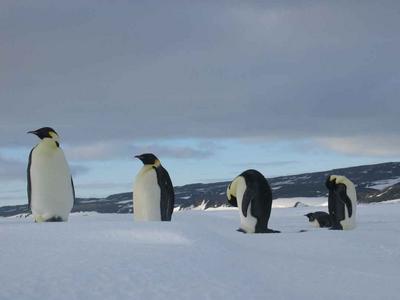
This is the first group of Emperor Penguins that we saw. They are 4 feet tall.
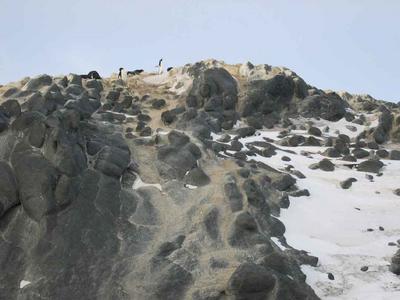
The Adelie Penguin colony at Cape Royds nests high atop this rocky area.
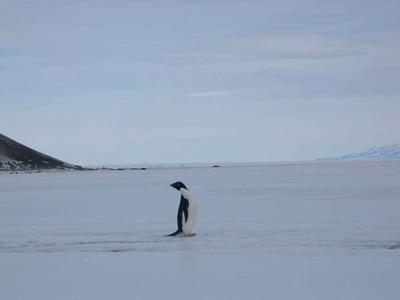
This lone Adelie was waddling out along the ice.
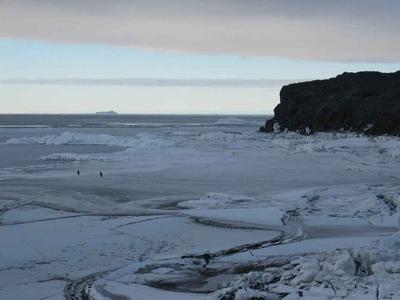
Not quite the edge of the ice, but close enough for us. This is a view looking north from Cape Royds.
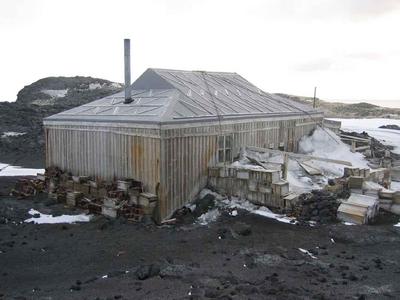
The hut built by Shackleton and his crew from the Nimrod.

There were crates of canned goods and jars such as this case of salt, around the hut.
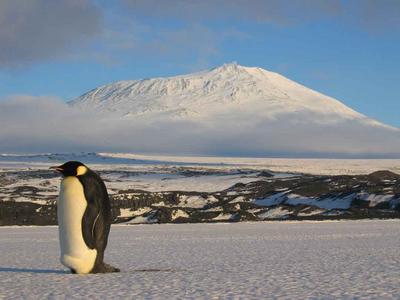
Antarctica--Emperor Penguin, ice, and Mt. Erebus under the midnight sun.
Contact the TEA in the field at
.
If you cannot connect through your browser, copy the
TEA's e-mail address in the "To:" line of
your favorite e-mail package.
|
